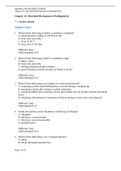Exam (elaborations)
OpenStax Microbiology Test Bank Chapter 15: Microbial Mechanisms of Pathogenicity Chapter 15: Microbial Mechanisms of Pathogenicity * = Correct answer | 2022 update
- Course
- Institution
OpenStax Microbiology Test Bank Chapter 15: Microbial Mechanisms of Pathogenicity Chapter 15: Microbial Mechanisms of Pathogenicity * = Correct answer Multiple Choice 1. Which of the following would be considered a symptom? A. blood pressure reading of 150/90 mm Hg B. body ache and chills* ...
[Show more]



